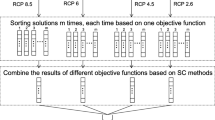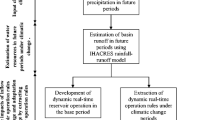Abstract
In order to mitigate the adverse impacts of climate change, adaptive operating rules (AOR) are generally derived using an ensemble of General Circulation Models (GCMs). Up to date, most of related literatures only focus on one fold of the following issues concerning the derivation of AOR using the GCMs ensemble, including: (1) consideration of different scenario weighing methods, or (2) analysis of different positions to locate scenario weights. And less concern is given to the latter compared with the former. However, few studies identify the relationship between (1) and (2) in the derivation of AOR based on the GCMs ensemble. In this study, we attempt to investigate where to use Equal and REA scenario weights in the derivation of reservoir operating rules under climate change. Equal weights (EW) and unequal weights based on the reliability ensemble average (REA) method are used in two positions: (I) the optimization objective of the reservoir operation model, which is to maximize the weighted average hydropower generation for all future scenarios; and (II) the incorporation of GCMs ensemble climate projections into the weighted climate conditions, and then it is input into the reservoir operation model with the objective of maximizing annual hydropower generation. Four AORs, including EW-AOR(I), REA-AOR(I), EW-AOR(II) and REA-AOR(II), are derived, and their optimized parameters are obtained by the simulation-based optimization (SBO) method with the Complex algorithm. The case study in the Jinxi Reservoir in China indicates that REA-AOR(I) outperforms the other three operation schemes, and EW-AOR(II) performs better than REA-AOR(II). Therefore, equal weights are preferably used to incorporate climate conditions, while unequal weights based on REA method can improve the performance of the reservoir operation model. Generally, REA-AOR(I) and EW-AOR(II) are suggested for adaptive reservoir management under climate change.






Similar content being viewed by others
References
Ahmadi M, Bozorg-Haddad O, Loaiciga HA (2015) Adaptive reservoir operation rules under climatic change. Water Resour Manag 29(4):1247–1266. https://doi.org/10.1007/s11269-014-0871-0
Brekke LD, Maurer EP, Anderson JD, Dettinger MD, Townsley ES, Harrison A, Pruitt T (2009) Assessing reservoir operations risk under climate change. Water Resour Res 45:W04411. https://doi.org/10.1029/2008wr006941
Chen J, Brissette FP, Lucas-Picher P, Caya D (2017) Impacts of weighting climate models for hydro-meteorological climate change studies. J Hydrol 549:534–546. https://doi.org/10.1016/j.jhydrol.2017.04.025
Christensen NS, Lettenmaier DP (2007) A multimodel ensemble approach to assessment of climate change impacts on the hydrology and water resources of the Colorado River Basin. Hydrol Earth Syst Sci 11(4):1417–1434. https://doi.org/10.5194/hess-11-1417-2007
Eum HI, Simonovic SP (2010) Integrated reservoir management system for adaptation to climate change: the Nakdong River Basin in Korea. Water Resour Manag 24(13):3397–3417. https://doi.org/10.1007/s11269-010-9612-1
Evenson DE, Moseley JC (1970) Simulation/optimization techniques for multi-basin water resource planning. Water Resour Bull 6(5):725–736
Feng MY, Liu P, Guo SL, Gui ZL, Zhang XQ, Zhang W, Xiong LH (2017) Identifying changing patterns of reservoir operating rules under various inflow alteration scenarios. Adv Water Resour 104:23–36. https://doi.org/10.1016/j.advwatres.2017.03.003
Giorgi F, Mearns LO (2002) Calculation of average, uncertainty range, and reliability of regional climate changes from AOGCM simulations via the “reliability ensemble averaging” (REA) method. J Clim 15(10):1141–1158. https://doi.org/10.1175/1520-0442(2002)015<1141:coaura>2.0.co;2
Guo SL, Zhang HG, Chen H, Peng DZ, Liu P, Pang B (2004) A reservoir flood forecasting and control system for China. Hydrol Sci J 49(6):959–972. https://doi.org/10.1623/hysj.49.6.959.55728.
Haguma D, Leconte R, Krau S, Côté P, Brissette F (2015) Water resources optimization method in the context of climate change. J Water Resour Plan Manag 141(2). https://doi.org/10.1061/(asce)wr.1943-5452.0000445
Hargreaves GH, Samani ZA (1982) Estimating potential evapotranspiration. J Irrig Drain Div 108(3):225–230
Hashimoto T, Stedinger JR, Loucks DP (1982) Reliability, resiliency, and vulnerability criteria for water-resource system performance evaluation. Water Resour Res 18(1):14–20. https://doi.org/10.1029/WR018i001p00014
Herman JD, Giuliani M (2018) Policy tree optimization for threshold-based water resources management over multiple timescales. Environ Model Softw 99:39–51. https://doi.org/10.1016/j.envsoft.2017.09.016
Herman JD, Reed PM, Zeff HB, Characklis GW (2015) How should robustness be defined for water systems planning under change? J Water Resour Plan Manag 141(10). https://doi.org/10.1061/(asce)wr.1943-5452.0000509
Karami F, Dariane AB (2018) Many-objective multi-scenario algorithm for optimal reservoir operation under future uncertainties. Water Resour Manag. https://doi.org/10.1007/s11269-018-2025-2
Liu P, Guo SL, Xu XW, Chen JH (2011) Derivation of aggregation-based joint operating rule curves for cascade hydropower reservoirs. Water Resour Manag 25(13):3177–3200. https://doi.org/10.1007/s11269-011-9851-9
Loucks DP, Van Beek E (2005) Water resources systems planning and management: an introduction to methods, models and applications. UNESCO Publishing, Paris
Milly PCD, Betancourt J, Falkenmark M, Hirsch RM, Kundzewicz ZW, Lettenmaier DP, Stouffer RJ (2008) Stationarity is dead: whither water management? Science 319(5863):573–574. https://doi.org/10.1126/science.1151915
Ming B, Liu P, Guo SL, Zhang XQ, Feng MY, Wang XX (2017) Optimizing utility-scale photovoltaic power generation for integration into a hydropower reservoir by incorporating long- and short-term operational decisions. Appl Energy 204:432–445. https://doi.org/10.1016/j.apenergy.2017.07.045
Mohammed R, Scholz M (2017) Adaptation strategy to mitigate the impact of climate change on water resources in arid and semi-arid regions: a case study. Water Resour Manag 31(11):3557–3573. https://doi.org/10.1007/s11269-017-1685-7
Moss RH et al (2010) The next generation of scenarios for climate change research and assessment. Nature 463(7282):747–756. https://doi.org/10.1038/nature08823
Nalbantis I, Koutsoyiannis D (1997) A parametric rule for planning and management of multiple-reservoir systems. Water Resour Res 33(9):2165–2177. https://doi.org/10.1029/97wr01034
Oliveira R, Loucks DP (1997) Operating rules for multi-reservoir systems. Water Resour Res 33(4):839–852. https://doi.org/10.1029/96wr03745
Steinschneider S, Brown C (2012) Dynamic reservoir management with real-option risk hedging as a robust adaptation to nonstationary climate. Water Resour Res 48:W05524. https://doi.org/10.1029/2011wr011540
Ward MN, Brown CM, Baroang KM, Kaheil YH (2013) Reservoir performance and dynamic management under plausible assumptions of future climate over seasons to decades. Clim Chang 118(2):307–320. https://doi.org/10.1007/s10584-012-0616-0
Wood AW, Leung LR, Sridhar V, Lettenmaier DP (2004) Hydrologic implications of dynamical and statistical approaches to downscaling climate model outputs. Clim Chang 62(1-3):189–216. https://doi.org/10.1023/B:CLIM.0000013685.99609.9e
Xiong LH, Guo SL (1999) A two-parameter monthly water balance model and its application. J Hydrol 216(1-2):111–123. https://doi.org/10.1016/s0022-1694(98)00297-2
Xu SL (1992) Common algorithms for C language programme. Tsinghua University Press, Beijing. (in Chinese)
Xu Y, Gao XJ, Giorgi F (2010) Upgrades to the reliability ensemble averaging method for producing probabilistic climate-change projections. Clim Res 41(1):61–81. https://doi.org/10.3354/cr00835
Xu WZ, Zhao JS, Zhao TT, Wang ZJ (2015) Adaptive reservoir operation model incorporating nonstationary inflow prediction. J Water Resour Plan Manag 141(8):04014099. https://doi.org/10.1061/(asce)wr.1943-5452.0000502
Yang G, Guo SL, Li LP, Hong XJ, Wang L (2016) Multi-objective operating rules for Danjiangkou reservoir under climate change. Water Resour Manag 30(3):1183–1202. https://doi.org/10.1007/s11269-015-1220-7
Young GK (1967) Finding reservoir operating rules. J Hydraul Div 93(6):297–322
Zhang W, Liu P, Wang H, Chen J, Lei XH, Feng MY (2017a) Reservoir adaptive operating rules based on both of historical streamflow and future projections. J Hydrol 553:691–707. https://doi.org/10.1016/j.jhydrol.2017.08.031
Zhang W, Liu P, Wang H, Lei XH, Feng MY (2017b) Operating rules of irrigation reservoir under climate change and its application for the Dongwushi Reservoir in China. J Hydro Environ Res 16:34–44. https://doi.org/10.1016/j.jher.2017.05.003
Zhou YL, Guo SL (2013) Incorporating ecological requirement into multipurpose reservoir operating rule curves for adaptation to climate change. J Hydrol 498:153–164. https://doi.org/10.1016/j.jhydrol.2013.06.028
Acknowledgements
The authors would like to thank the editor and anonymous reviewers for their valuable suggestions, which helped to improve the quality of the paper. This study was supported by National Key Research and Development Project (2016YFC0402208), National Natural Science Foundation of China (Grant No.51709276) and National Key Technology R&D Program (2015BAB07B03).
Author information
Authors and Affiliations
Corresponding author
Ethics declarations
Conflict of Interest
The authors declare that they have no conflict of interest.
Additional information
Publisher’s Note
Springer Nature remains neutral with regard to jurisdictional claims in published maps and institutional affiliations.
Rights and permissions
About this article
Cite this article
Zhang, W., Lei, X., Liu, P. et al. Identifying the Relationship between Assignments of Scenario Weights and their Positions in the Derivation of Reservoir Operating Rules under Climate Change. Water Resour Manage 33, 261–279 (2019). https://doi.org/10.1007/s11269-018-2101-7
Received:
Accepted:
Published:
Issue Date:
DOI: https://doi.org/10.1007/s11269-018-2101-7




